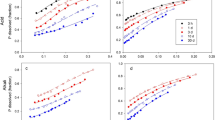Abstract
Kinetics of H+ consumption by mineral dissolution in a surface soil and a subsoil of an acid woodland soil were studied by means of batch type experiments and stationary pH titrations. Mineral dissolution in the subsoil could effectively be described by congruent dissolution of illite (K0.6Mg0.25A12.3S13010(OH)2) followed by an incongruent dissolution stage. In the incongruent stage the concentration of Al decreased while concentrations of K and Mg continued to increase. Congruent dissolution rates of illite could be predicted with power type relationships from transition state theory. In the incongruent dissolution stage the activities of H and Al appeared to be controlled by precipitation of A1(OH)3. Results of this kind of experiments could be helpful to understand the behavior of Al and base cations in acid soils and soils with high atmospheric loadings of acid. Comparison of the results of batch experiments for a surface soil and a subsoil showed that initially proton consumption in the surface soil is faster and more effective due to the presence of a relatively high cation exchange capacity and base saturation value. However with progressive proton consumption and increasing reaction times proton consumption in the subsoil becomes faster than in the surface soil, presumably due to higher rates of mineral dissolution in the subsoil. Lower dissolution rates in the surface soil may result from lower contents of easily weatherable minerals, due to excessive leaching in the past which is reflected in a 17% lower acid neutralizing capacity than in the subsoil.
Similar content being viewed by others
References
Aagaard, P. and Helgeson, H.C.: 1982, Amer. J. Sci. 282, 237.
Begheijn, L.Th.: 1980, Methods of chemical analysis for soils and waters. Agricultural University, Wageningen, The Netherlands.
Busenberg, E. and Clemency, C.V., 1976. Geoch. et Cosmoch. Acta. 40, 41.
EPRI: 1983, The Integrated Lake-Watershed Acidification Study. Volume 1. Model principles and application procedures. Report EA-3221. TETRA Tech. Inc., Lafayette Ca, USA.
Helgeson, H.C., Murphy, W.M. and Aagaard, P.: 1984, Geoch. et Cosmoch. Acta. 48, 2405.
Kilsdonk, A.C.M.: 1977, Non-Linear Optimization package OPTPAC 3. Program description and reference manual. ISA-DSA Scientific Computer Application, no UDV-DSA/SCA/TU/77/054/ap, N.V. Philips, Eindhoven, The Netherlands.
Lasaga, A.C.: 1983, Kinetics of silicate dissolution. Proc. 4th Int. Conf. Water Rock Interaction. p 269–274.
Mulder, J., Van Grinsven, J.J.M. and Van Breemen, N.: 1986, Hydrochemical budgets of woodland soils affected by atmospheric deposition. III. Aluminum Chemistry. (submitted to S.S.S.A.J.)
U.S. Department of Agriculture, Soil Conservation Service: 1975, Soil Taxonomy, US Government Printing Office, Washington D.C..
Van Breemen, N., Driscoll, C.T. and Mulder, J.: 1984, Nature 307, 599.
Author information
Authors and Affiliations
Rights and permissions
About this article
Cite this article
van Grinsven, J.J.M., Kloeg, G.D.R. & van Riemsdijk, W.H. Kinetics and mechanism of mineral dissolution in a soil at pH values below 4. Water, Air, and Soil Pollution 31, 981–990 (1986). https://doi.org/10.1007/BF00284244
Issue Date:
DOI: https://doi.org/10.1007/BF00284244




